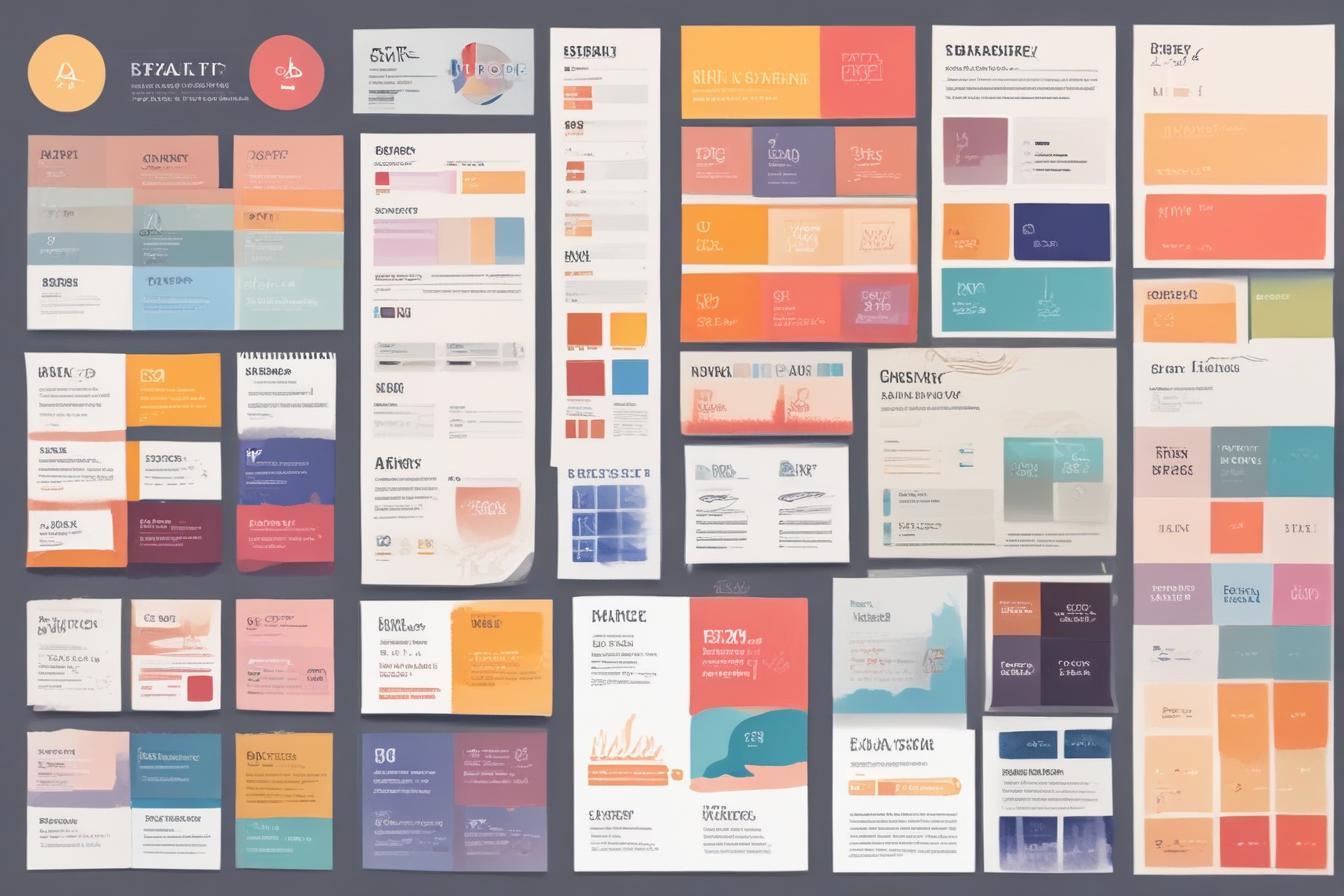What Are Brand Guidelines and Why Do They Matter?
In today’s crowded and competitive digital landscape, having a strong brand identity is more important than ever. Brand guidelines, also known as style guides or brand bibles, are the foundational documents that outline the core elements of your brand’s visual and written identity. These guidelines serve as a comprehensive rulebook that ensures consistency across all touchpoints, from your website and marketing materials to your product packaging and social media presence.
Maintaining Brand Consistency
Brand consistency is crucial for building recognition, trust, and loyalty among your target audience. Imagine walking into a McDonald’s restaurant and being greeted by a minimalist, high-end interior with servers in formal attire – it would be completely jarring and incongruous with the brand you know and love. That’s the power of consistent branding. When your messaging, visuals, and overall brand experience align seamlessly, you create a cohesive and memorable impression that resonates with your customers.
Scalability and Efficiency
Brand guidelines don’t just ensure consistency; they also facilitate scalability and efficiency within your organization. By having a centralized set of rules and assets, you empower your team members, partners, and vendors to create on-brand content and materials without constantly reinventing the wheel. This streamlines workflows, reduces mistakes, and ultimately saves time and money.

Key Elements of Effective Brand Guidelines Content
Comprehensive brand guidelines should cover all aspects of your brand’s identity, ranging from the written word to visual design elements. While the specific components may vary depending on your industry and brand, most guidelines include the following key elements:
Brand Story and Values
At the core of your brand guidelines should be a clear articulation of your brand’s story, mission, vision, and values. This foundational narrative serves as the guiding light for all your branding efforts, ensuring that your messaging and visuals consistently reinforce your brand’s unique personality and purpose.
Logo Usage
Your logo is often the most recognizable aspect of your brand, so it’s essential to provide clear guidelines on its proper usage. This includes specifications on color variations, sizing, clear space requirements, and acceptable backgrounds or placements.
Color Palette
A consistent color palette is a powerful branding tool that can evoke specific emotions and associations. Your brand guidelines should define the primary and secondary colors, along with their respective hex, RGB, and CMYK values for seamless implementation across various mediums.

Writing Brand Voice and Tone Guidelines
While visual elements are crucial, your brand’s written communication is equally important in shaping your audience’s perception. That’s why comprehensive brand guidelines should include detailed instructions on your brand’s voice and tone.
Defining Your Brand Voice
Your brand voice encompasses the personality and core characteristics that come through in your written content. Is your brand friendly and approachable, or more formal and authoritative? Are you playful and witty, or straightforward and practical? Defining your brand voice ensures that your messaging stays true to your brand’s unique identity, no matter who’s writing it.
Establishing Tone Guidelines
Tone, on the other hand, refers to the specific attitude or emotion conveyed in a particular piece of content. While your brand voice remains consistent, the tone may shift depending on the context or situation. For example, a social media post celebrating a company milestone might have a more celebratory and enthusiastic tone, while a crisis communication would call for a more empathetic and reassuring tone.
By providing clear guidelines on tone adaptation, you ensure that your content remains authentic and appropriate, no matter the circumstances.
If you’re looking to streamline the process of creating on-brand, SEO-optimized content at scale, ContentScale.fr is an online tool that leverages AI to generate high-quality articles tailored to your brand guidelines. With their AI-powered platform, you can produce compelling, consistent content without the need for a dedicated SEO agency or content writer, saving you time and money while keeping you ahead of the competition.

Creating Visual Style Guides for Design Assets
While written content is essential, visual elements play a crucial role in shaping your brand’s identity. Effective brand guidelines should provide detailed specifications for various design assets, ensuring a cohesive and recognizable aesthetic across all platforms.
Typography
Typography is a powerful tool for conveying your brand’s personality and enhancing readability. Your brand guidelines should specify the primary and secondary typefaces, along with guidelines for their usage, such as hierarchy, sizing, and spacing.
Iconography and Illustrations
If your brand utilizes custom icons or illustrations, your guidelines should outline the appropriate styles, color palettes, and usage scenarios. This ensures consistency and prevents misuse or misrepresentation of these visual elements.
Photography and Videography
Visual content like photographs and videos can significantly impact your brand’s overall aesthetic. Your guidelines should define the preferred styles, subjects, and treatments for these assets, ensuring they align with your brand’s personality and values.

Ensuring Message Consistency Across All Channels
In today’s multi-channel world, it’s essential to maintain consistent messaging and branding across all touchpoints, both online and offline. Your brand guidelines should provide clear directives for various communication channels, ensuring a seamless and cohesive brand experience for your audience.
Digital Channels
From your website and social media platforms to email marketing and digital advertising, your digital presence is often the first point of contact for many potential customers. Your brand guidelines should outline best practices for maintaining a consistent look, feel, and tone across these channels.
Print and Physical Collateral
While digital channels are crucial, traditional print and physical materials still play a significant role in brand communication. Your guidelines should cover everything from business cards and brochures to product packaging and signage, ensuring a unified brand experience in the physical world.
Event and Experiential Branding
Conferences, trade shows, and experiential marketing events offer valuable opportunities to connect with your audience in person. However, these experiences can quickly undermine your brand if not executed properly. Your brand guidelines should provide clear directives for event branding, including booth design, staff attire, and on-site activations.
By leveraging AI-powered content generation tools like ContentScale.fr, you can effortlessly create consistent, on-brand content for various channels, from social media posts and email campaigns to website copy and blog articles. Their AI technology ensures your messaging stays true to your brand guidelines while optimizing for search engines, allowing you to scale your content efforts without sacrificing quality or consistency.

Examples of Exceptional Brand Guidelines Content
To truly understand the power and impact of well-crafted brand guidelines, let’s take a look at some exceptional examples from industry-leading brands:
Spotify
Spotify’s brand guidelines are a masterclass in conveying a brand’s personality through storytelling and visuals. Their guidelines delve deep into their brand narrative, exploring their mission, values, and the philosophies that shape their brand experience. The visuals are bold, vibrant, and consistently reinforce their identity as a modern, innovative music streaming service.
Mailchimp
Known for their quirky and playful brand personality, Mailchimp’s brand guidelines are a delight to explore. Their tone is conversational and infused with humor, yet still professional and informative. The visuals are whimsical and imaginative, featuring their beloved brand mascot, Freddie, in various scenarios.
Airbnb
Airbnb’s brand guidelines showcase their commitment to creating a sense of belonging and human connection. Their guidelines are beautifully designed, with a strong emphasis on visual storytelling and diverse representation. The tone is warm, inclusive, and inviting, perfectly aligning with their mission of facilitating meaningful travel experiences.
These exceptional examples demonstrate the power of comprehensive and well-executed brand guidelines in shaping a memorable and consistent brand experience. By investing in the development of robust guidelines, brands can ensure their messaging and visuals resonate with their target audience, ultimately fostering brand loyalty and long-term success.

Best Practices for Maintaining and Updating Guidelines
Creating comprehensive brand guidelines is just the first step; maintaining and updating them is equally crucial. As your brand evolves and your business grows, your guidelines must adapt to reflect these changes. Here are some best practices to keep in mind:
Establish Clear Governance
Designate a dedicated team or individual responsible for managing and enforcing your brand guidelines. This team should have the authority to review and approve all brand-related materials, ensuring adherence to the guidelines.
Conduct Regular Audits
Periodically assess your brand’s presence across all channels, evaluating consistency and identifying areas for improvement. This proactive approach allows you to address any deviations from your guidelines before they become widespread issues.
Stay Agile and Adaptable
While consistency is crucial, your brand guidelines should also be flexible enough to evolve with changing market trends, consumer preferences, and business needs. Regularly review and update your guidelines to ensure they remain relevant and effective.
Provide Training and Resources
Ensure that all stakeholders, from internal teams to external partners and vendors, have access to your brand guidelines and receive proper training on their implementation. This empowers everyone to contribute to a consistent and cohesive brand experience.
As you maintain and update your brand guidelines, consider leveraging AI-powered content generation tools like ContentScale.fr. Their platform allows you to seamlessly integrate your brand guidelines, ensuring that all generated content adheres to your voice, tone, and visual style. This not only streamlines your content creation process but also ensures consistent, on-brand messaging across all channels.
By following these best practices and embracing innovative technologies like AI-powered content generation, you can maintain a strong, consistent brand identity that resonates with your audience and drives long-term success.
Conclusion and Call-to-Action
In today’s competitive landscape, having a consistent and compelling brand identity is essential for standing out and building lasting connections with your audience. Comprehensive brand guidelines are the foundation upon which this identity is built, guiding every aspect of your brand’s visual and written communication.
By investing in well-crafted brand guidelines and following best practices for maintenance and updates, you can create a cohesive, recognizable brand experience that fosters trust, loyalty, and long-term success. Embrace innovative tools like ContentScale.fr to streamline your content creation efforts while ensuring adherence to your brand guidelines, saving time and resources without sacrificing quality or consistency.
Take the first step towards a stronger, more consistent brand identity today. Explore ContentScale.fr’s AI-powered content generation platform and discover how it can revolutionize your content strategy while keeping your brand at the forefront.
